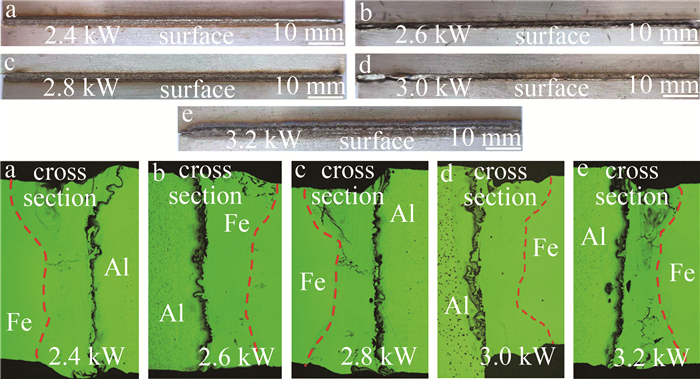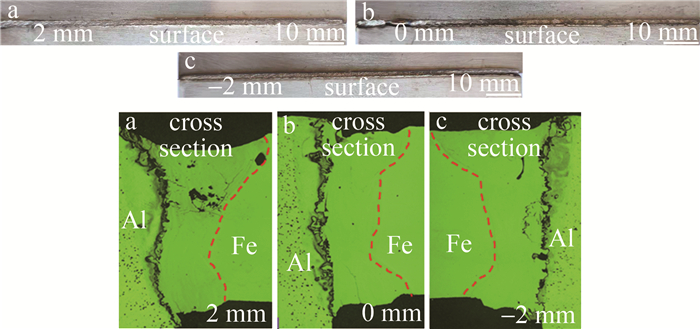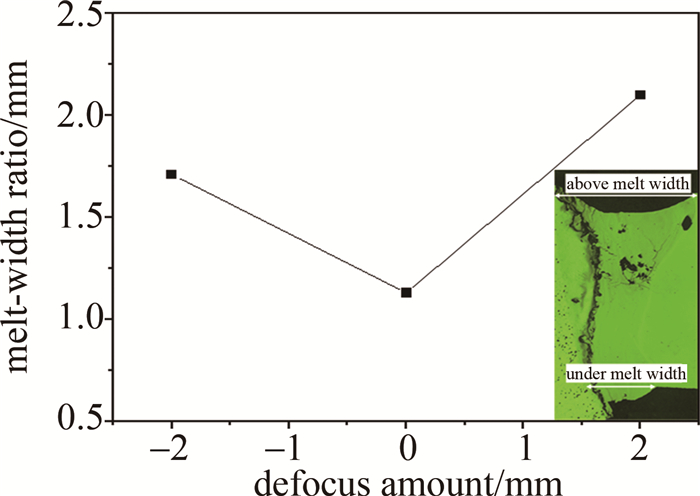HTML
-
近年来,在汽车轻量化、工业材料多元化的趋势下,单一铝或钢产品的应用已不能完全符合碳中和的发展主题,因此,提升异种金属连接件性能显得尤为关键。铝/钢连接可以有效减重,实现节能减排,也可拓宽铝/钢材料应用范围[1],由于铝/钢熔点、延展性、热导率、密度等物理化学性质差异较大[2],导致焊后接头冷却过程中易产生FeAl、FeAl3、FeAl7、Fe2Al5、FeAl2等二元脆性化合物,降低接头质量,严重限制了在特定场景下的应用。
为了不断满足应用需求,国内外科技工作者尝试了多种方法来改善铝/钢焊接头质量。CAO等人[3]研究了中间层对铝/钢激光搭接焊的影响,结果表明:Cu/Ni复合中间层的加入充分改变冶金反应,有效减少Fe-Al二元化合物的生成,提升接头质量。BA等人[4]利用激光摆动技术研究了激光功率对铝/钢搭接焊的影响,结果表明:当激光功率为1.4 kW时能得到缺陷较少、抗拉强度明显提高的铝/钢接头。HAN等人[5]研究了不同搭接方式对铝/钢激光焊接接头影响,结果表明:采用铝下钢上的搭接方式获得的接头焊缝深宽比大于1,接头界面化合物主要为Fe2Al5,且形态和分布明显改善,接头抗剪强度相比铝上钢下焊接方式获得的焊接头也有明显提升。以上报道虽实现铝/钢有效连接,接头性能也有所改善,但存在的共同问题为:搭焊接头铝/钢相互接触面积较大,接头厚度增加,焊接件应用限制较大,而采用对接焊的方式可有效解决此问题。另外,当激光垂直作用于接头中央,因两者熔点差异,熔融不同步[6],增加焊接缺陷产生,接头性能无法保障。YANG等人[7]和CASALINO等人[8]采用激光向钢侧偏置的方式进行铝/钢焊接,结果表明:铝侧烧结现象减少,焊缝熔合良好,接头性能明显改善。
本文中将激光向钢侧偏置进行不等厚铝/钢对接焊实验,通过调整焊接参数获得性能良好的焊接头,并对焊缝微观组织进行深入分析。
-
实验材料为150 mm×65 mm×4 mm的304不锈钢和150 mm×65 mm×8 mm的6061铝。化学成分见表 1和表 2,力学性能见表 3。
C Mn P S Si Cr Ni Fe ≤0.0008 ≤0.02 ≤0.00045 ≤0.0003 ≤0.01 ≤0.18~0.2 ≤0.08~0.105 balance Table 1. Chemical composition(mass fraction)of 304 stainless steel
Si Mg Mn Cu Zn Fe Al ≤0.004~0.008 ≤0.008~0.012 ≤0.0015 ≤0.0015~0.004 ≤0.0025 ≤0.007 balance Table 2. Chemical composition(mass fraction)of 6061 aluminum alloy
type tensile strength/
MPayield strength/
MPabending strength/
MPahardness/
HV6061 aluminium 124 55.2 228 60 304 steel 520 205 40 200 Table 3. Mechanical properties of 6061 aluminum alloy and 304 stainless steel
-
实验中采用德国通快公司型号为HL4006D的Nd∶YAG激光器。实验前先将待焊母材用砂纸去除表面氧化膜,并用丙酮对母材表面进行超声清洗、真空干燥炉烘干,然后将待焊母材用特定夹具固定在试验台上,将激光偏移至钢侧设定位置。焊接工艺参数见表 4,焊接示意图如图 1所示。
number power/
kWdefocus amount/
mmvelocity/
(m·min-1)offset/
mma 2.4 0 1.8 0.3 b 2.6 0 1.8 0.3 c 2.8 0 1.8 0.3 d 3.0 0 1.8 0.3 e 3.2 0 1.8 0.3 f 3.0 +2 1.8 0.3 g 3.0 0 1.8 0.3 h 3.0 -2 1.8 0.3 Table 4. Aluminum/steel laser welding process parameter
完成焊接实验后,切割获得标准拉伸试样(如图 2所示),利用万能试验机测试接头抗拉强度,并对拉伸断口进行X射线衍射物相分析。在焊接区域进行12 mm×10 mm金相切割和镶嵌打磨,用配比为(1.5 mL HF+2.5 mL HCl+3 mL HNO3+50 mL H2O)的凯勒试剂和FeAl3溶液分别对铝侧和钢侧进行15 s和30 s的腐蚀,在光镜下观察焊缝区域宏观形貌,利用扫描电镜及其配备的能谱分析仪(energy dispersive spectrometer,EDS)观察焊缝区微观组织形貌并分析元素组成。使用MH-60显微硬度仪在焊缝区域间距0.1 mm,进行载荷1.962 N保载时间10 s的显微硬度测试。
1.1. 实验材料
1.2. 实验方法及过程
-
图 3a~图 3e(对应表 4中试样a~e)所示为激光功率在2.4 kW~3.2 kW内变化的接头表面与截面形貌。从图 3中表面形貌可知,随着激光功率的增加,焊缝表面平整度逐渐提升。激光功率2.4 kW时,焊缝表面凹陷明显;激光功率2.6 kW时,焊缝表面飞溅较多;激光功率升至3.0 kW,焊缝表面整体飞溅减少无明显裂纹,焊缝整体饱满均匀无塌陷,接头成型最为美观;激光功率升至3.2 kW时,焊缝熔宽明显增加,焊缝表面粗糙度增大。对照图 3a~图 3e截面形貌可以看到,随着激光功率的增大,焊缝整体形状由字母“Y”转变为字母“X”。激光功率3.0 kW时,焊缝上下熔宽比较接近,激光功率继续增加至3.2 kW,钢侧焊缝裂纹以及熔合线上气孔缺陷增多。
图 4a~图 4c(对应表 4中试样f~h)为保持激光功率3.0 kW、焊接速率1.8 m/min、偏移量0.3 mm、离焦量在2 mm~-2 mm内变化时接头表面与截面形貌。从图中可以看到,离焦量为2 mm时,焊缝表面飞溅较多且轻微塌陷;当离焦量变为0 mm时,此现象明显改善;当离焦量调整为-2 mm时,铝/钢两侧熔合比例适中,沿焊接方向无细小裂纹,焊缝无塌陷,表面成型最优。对照图 4a~图 4c的截面形貌可以看到,离焦量为2 mm时,接头焊缝上端塌陷最深,界面熔合线犬牙交错整体呈“S”形。焊缝中间区域存在明显的气孔和裂纹,其原因为熔池冷却过程中发生冶金反应生成铁-铝化合物并伴随出现裂纹、气孔、夹杂等缺陷[9-11]。离焦量变为-2 mm时,熔合线逐渐平直,铝侧熔融面积增大[12-13],焊缝上部塌陷消失,熔合线上咬边、气孔缺陷减少。离焦量由2 mm变为-2 mm时,焊缝上下熔宽比值由2.1变为1.77(见图 5),这是由于离焦量由正到负变化,接头底端熔融增多,同一焊缝上下熔宽逐渐接近。综合可知,本实验中激光功率3.0 kW、焊接速率1.8 m/min、偏移量0.3 mm、离焦量-2 mm时,获得的接头表面和截面形貌最好、缺陷最少,所以此焊接工艺最为稳定。
-
图 6为试样h(见图 4c)焊缝截面的宏观形貌。图 7a为图 6焊缝标记区域(见K点)的放大图,图 7b为图 6焊缝标记区域(见P点)的放大图。图 7a和图 7b中标记点1~7为光镜下观察到的组织形态。从图 7a和图 7b中可知,在标记点1和7处存在沿钢侧连续锯齿状物质生成。在其他学者[13-14]的研究中也同样表明,与标记点1、7处形态类似的锯齿状物质为Fe4Al13,其生成原因与紧邻钢侧有关。标记点2、3、4处分别能观察到絮状、正方形块状和米粒状物质,标记点5、6处为粗大和细小针状混合物,同时可观察到标记点2~6都位于界面或铝浓度较高的铝侧焊缝内。同样有学者[15-17]研究发现,标记点2~6针状、棒状物为FeAl3、FeAl以及Fe4Al13。因此图 7a和图 7b靠近铝侧焊缝标记点2~6应为富铝相铁-铝化合物。
图 8a和图 8b为图 6中K点的微观组织形貌图。A~E点的能谱仪(energy dispersive spectrometer,EDS)分析结果见表 5。图 8a中区域划分依据为图 8b中铁、铝元素含量曲线的变化趋势。由图 8b可知,在区域Ⅰ~Ⅲ内铝元素含量呈陡坡式下降,铁元素含量缓慢上升,进入区域Ⅳ后铁铝原子比例稳定在2:3,因此判断Ⅰ~Ⅲ为过渡区,Ⅳ为稳定区。在图 8a区域Ⅰ内可观察到形状不规则的大面积絮状物,在其上A点测得铁原子的原子数分数为0.16,铝原子的原子数分数为0.7527,结合A点铁、铝原子比例以及常温下铁在铝中的溶解度可知,铁原子以化合物的形式存在于此处,A点及其周围发生Al+Fe2Al5=2FeAl3反应[11],因此A处化合物为FeAl3,另有Al基固溶体生成。在图 8a区域Ⅱ内能明显观察到界面熔合线,熔合线上B点测得铁原子的原子数分数为0.4508,铝原子的原子数分数为0.3071,铬原子的原子数分数0.1404,由于B点紧邻钢侧铁含量较高,又在铁、铝冶金反应中根据吉布斯自由能铁-铝化合物生成的难易程度,一般认为Fe2Al5最先生成[18],综合铁、铝原子比例关系推断B点生成化合物为Fe2Al5。标记点C与区域Ⅰ中A点原子比例相似,推断两点存在化合物一致。除此之外熔合线上还存在冷却过程中元素Cr的富集结晶现象。图 8a区域Ⅲ、Ⅳ形貌平整,钢侧焊缝特征明显。D和E两点EDS元素检测显示,铁、铝原子含量比例稳定在3:2,由于区域Ⅲ、Ⅳ位于钢侧焊缝,又有D、E两处铝原子含量未超出在铁中最大溶解度32%[13],因此铝应以固溶体形式在钢侧焊缝与析出的Cr共存。综合A~E 5点原子比例可知,区域Ⅰ、Ⅱ内分布大量铁-铝化合物及固溶体组织,微观形态呈絮状,垂直于界面熔合线向铝侧生长;区域Ⅲ、Ⅳ铝原子扩散厚含量不高,化合物生成较少。
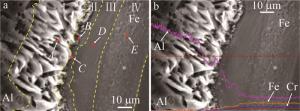
Figure 8. Microstructure and EDS analysis of mark region point K in Fig. 6
location element phase composition Fe Al Cr A 0.16 0.753 0.032 FeAl3,Al solid B 0.451 0.307 0.140 Fe2Al5,Fe solid,Cr C 0.139 0.756 0.039 FeAl3,Al solid D 0.462 0.309 0.141 Al,Fe solid,Cr E 0.475 0.273 0.152 Al,Fe solid,Cr F 0.235 0.730 0.019 Fe4Al13,Cr G 0.582 0.172 0.177 Al solid,Cr,Fe3Al H 0.581 0.173 0.172 Al solid,Cr,Fe3Al 图 9a和图 9b为图 6中位置P的微观组织形貌。F~H点的EDS分析结果见表 5。图 9a中区域划分依据为图 9b中铁、铝元素含量曲线的变化趋势。在图 9a中区域Ⅴ内可明显看到“蜂巢状”组织,其左侧为铝基腐蚀后典型特征。区域Ⅴ左侧虚线位置出现微观裂纹,原因是:左侧组织为铝基,与右侧铁-铝原子扩散后形成组织有明显区别,在两者交界位置产生应力集中,故沿区域Ⅴ左边界黄色虚线出现微观裂纹。对区域Ⅴ内位于界面铝侧组织上F点进行元素检测结果显示,铁、铝、铬原子比例约为4:13:1,Fe原子的原子数分数远低于Al。WEI等人[18]的研究表明:紧邻熔合线铝侧内会生成不均匀的Fe4Al13。结合本文中EDS检测结果,F点生成物质应为Al固溶体+Fe4Al13,同时还存在钢熔融后析出的Cr。另一可能是:铁原子数分数介于0.50~0.55范围之内,Cr原子和Fe原子发生反应生成了脆性相Fe2CrAl[19]。区域Ⅵ内存在明显铝/钢熔合线,其上G点及其右侧H点的元素检测显示,铁、铝、铬原子比例为3∶1∶1,由原子比例可知,此区域铝原子的原子数分数较低,焊缝冷却过程中可与铁充分反应被完全消耗,结合X射线衍射仪(X-ray diffraction,XRD)物相检测结果,生成组织为富铁相Fe3Al+单质Cr。
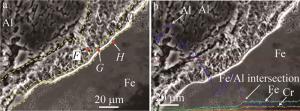
Figure 9. Microstructure and EDS analysis of marked region point P in Fig. 6
通过对图 6中焊缝截面位置K、P点的微观组织(见图 8和图 9)对比分析可知,焊缝标记点K处主要组织为FeAl3、Fe2Al5以及Fe、Al固溶体,标记点P处生成化合物为Fe4Al13、Fe2AlCr和Fe3Al。其原因为K和P分别处于焊缝中、下部,激光作用下铁-铝扩散情况不同,焊缝上部K处对于生成连续铁-铝化合物层表现出了更大的趋向性[20]。
由图 8和图 9中标记点A~H的EDS元素(见表 5)和XRD(见图 10)物相分析可知,铝/钢焊缝存在众多铁-铝化合物,其中Fe3Al只在铝侧及界面少量出现(见图 8a中区域Ⅰ和Ⅱ),FeAl3、Fe2Al5、FeAl在焊缝含量较多分布无明显规律。从XRD衍射峰强度可知,除铁-铝化合物外,焊缝部分位置还存在铁、铝固溶体组织。
图 11a~图 11d分别为熔池冷却演变过程示意图。结合铝/钢实际焊接过程可知,熔池存在时间极短[11](小于1 s)。由铁-铝相变(见图 12)可以看到,当温度处于1538 ℃以上时形成熔池铁铝快速扩散,随着温度下降,α-Fe固溶体大量析出,温度降至1171 ℃左右,熔池内铝浓度持续增高,铁、铝发生多种冶金反应生成Fe2Al5,FeAl,FeAl3,在界面区域能观察到针状和锯齿状物质(见图 7);当温度降低至660 ℃以下,熔池基本成型凝固,已形成化合物在余温影响下继续消耗焊缝界面区残留铁铝原子,发生进一步反应[18]生成富铝相Fe4Al13或富铁相Fe3Al。最终焊缝完全冷却成型。
-
图 13为图 3a~图 3e拉伸件的抗拉强度关系图。由图可知,随着激光功率增大,接头抗拉强度整体缓慢上升,其中激光功率为3 kW时,接头抗拉强度达到最大38 MPa,激光功率继续升至3.2 kW,接头抗拉伸强度出现下降。图 14为图 4a~图 4c拉伸件拉伸强度柱状图。由图可知,离焦量由2 mm变为-2 mm时,接头抗拉强度提升显著,其中离焦量为-2 mm时,接头抗拉伸强度达到最高57.7 MPa。
图 15a和图 15b为图 6接头断口铝侧和钢侧表面微观形貌。断口表面1~4点EDS分析结果见表 6。在图 15中铝侧和钢侧断口表面均未发现拉伸韧窝,而大面积存在细小撕裂纹,这说明铝/钢焊接拉伸断口为脆性断裂。在图 15a铝侧可以看到拉伸断裂形貌呈现河流浪花状,存在诸多细小剥落层状结构。在图 15b钢侧断口表面能明显看到较多密集条状物质与密集“蜂窝孔”状结构存在。根据图 15中标记点1、2 EDS能谱元素分析结果可知,判断标记点1和2所处位置的组织结构为FeAl与少量FeAl3及Fe2CrAl的混合物,其中脆性Fe2CrAl相的存在严重降低接头质量。3和4处存在条状和孔状结构,经EDS能谱元素分析为拉伸过程中脆性化合物Fe4Al13解离、脱落形成。除此之外,铝/钢断口表面还存在较多凹陷,EDS检测显示凹陷内存在化合物Fe3Al。由LIU等人[21]的研究可知,利用第一性原理计算FeAl2、Fe3Al相对于其它铁-铝化合物表现出韧性。因此拉伸凹陷形成由化合物Fe3Al拉伸断裂造成。
location element phase composition Fe Al Cr 1 0.106 0.754 0.044 Al solid、FeAl3 2 0.211 0.626 0.098 FeAl3 3 0.192 0.667 0.018 Fe3Al 4 0.035 0.878 0.010 Al solid Table 6. Chemical elements and phase composition (atomic fraction) of the fracture marked region in Fig. 15
图 16为图 6焊缝截面显微硬度测试。由图可知,以铝/钢界面为起点向两侧拓展对焊缝区域进行显微硬度测试。其中在铝/钢界面区域硬度值(60 HV~500 HV)波动较大,原因为铝/钢界面在铝/钢液态下熔池相互混合冷却过程中生成种类繁杂,且脆硬不一的铁-铝化合物及固溶体;进入钢侧焊缝后,由EDS分析结果可知,此区域组织成分稳定,少量铝元素扩散起到固溶强化作用,硬度平均值(536 HV)为整个焊缝区域最高;随着向钢侧不断延伸,硬度值快速下降,直至钢侧母材,硬度值在200 HV上下浮动。
2.1. 工艺参数对接头形貌的影响
2.2. 最优参数接头焊缝组织分析
2.3. 接头力学性能分析
-
(1) 激光功率3.0 kW、焊接速率1.8 m/min、离焦量0 mm、激光偏移量0.3 mm时,接头抗拉强度达到38 MPa。保持其它焊接参数不变,离焦量为-2 mm时,接头抗拉强度提升至57.7 MPa,达到铝合金母材的40%。
(2) 调整离焦量促进熔池流动,焊缝表面裂纹、气孔缺陷改善,界面熔合线更加整齐。离焦量为-2 mm时,接头焊缝中上部界面区域生成化合物为FeAl3,FeAl,Fe2Al5,底部生成化合物为Fe4Al13,Fe3Al,FeAl3。
(3) 接头拉伸断裂模式为脆性断裂,断裂行为发生在铝/钢界面过渡层,界面区域由于铁-铝化合物分布不均使显微硬度在60 HV~500 HV内波动。
(4) 断口表面化合物主要为Fe3Al,FeAl3,FeAl及Fe4Al13。部分拉伸断裂形成的凹陷处检测发现化合物Fe3Al,拉伸断裂形成的片层状结构上检测发现化合物FeAl3,FeAl,Fe4Al13。

 Map
Map






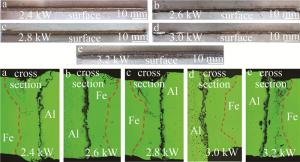
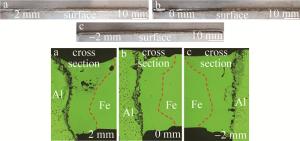
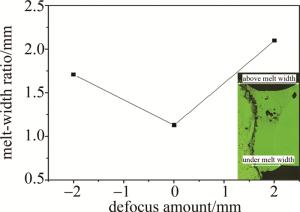

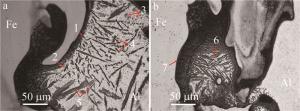

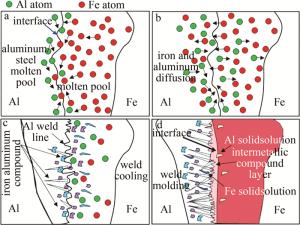
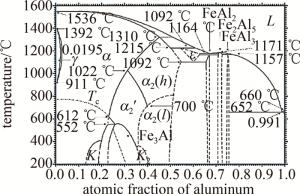
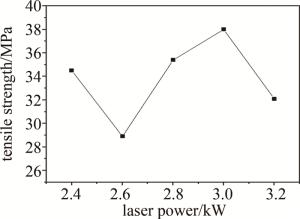
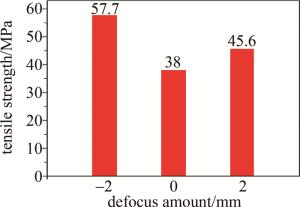

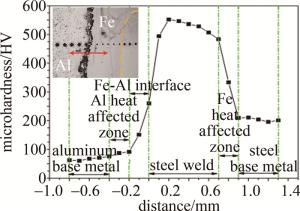
 DownLoad:
DownLoad:


